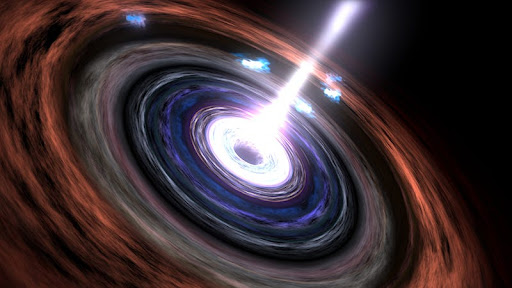
Blazars are feeding supermassive black holes that sit at the hearts of active galaxies, blasting out enormous jets of radiation and matter. But unlike quasars, the cosmic twin of a blazar, these phenomena are pointed directly at Earth.
And according to new research, they could actually be pelting our planet with neutrinos — otherwise known as "ghost particles."
This spooky moniker comes from the fact neutrinos are notoriously difficult to detect. They are chargeless, and have virtually no mass. Around 65 billion neutrinos manage to stream through every square inch of your body every single second with no discernible effect.
So unsurprisingly, neutrinos are considered the "ghosts" haunting the particle zoo. Fascinatingly, however, their ghost-like nature also makes them important probes of the universe. This is because neutrinos can "phase" through obstacles, such as dense dust clouds, that impede other forms of matter and even light.
Therefore, understanding where exactly neutrinos are coming from in the cosmos is vital. And this new research brings scientists a step closer to establishing blazars as the source of the astrophysical ghosts.
Related: 100 black hole jets aimed at Earth unleash controversial physics theory
Where gamma-rays come in
Blazars are a subset of bright, active galactic nuclei (AGNs) or "quasars," which are bright enough to outshine the combined light of every single star in the galaxy that houses them. Blazars are only different from standard quasars in that they keep our planet dead in their sights when emitting material from their cores at near-light speeds.
The jets emitted in blazar flare events are composed of high-energy particles known as cosmic rays that can stretch across many light-years, even extending well beyond the limits of the galaxies these phenomena are situated within. These jets also consist of electromagnetic radiation ranging from low-energy radio waves to extremely high-energy gamma rays.
And importantly, when cosmic rays interact with particles of light , or photons , they are believed to create showers of none other than neutrinos. Thus, gamma-ray flares from AGNs have long-been the prime suspect in the hunt for neutrino particles detected in our sky.
The link between considerably less conspicuous AGN jets and neutrinos was solidified in 2017, when the IceCube neutrino detector buried deep under the North Pole spotted a high-energy neutrino event coinciding with the flare of a blazar called TXS 0506+056. They were connected in terms of location and timing. TXS 0506+056 emerges from a supermassive black hole powered AGN located around 5.7 billion light-years away from Earth.
Yet, the actual relationship between the blazar flare patterns and the amount of neutrinos passing through Earth — the neutrino flux — remained shrouded in mystery.
'On-duty' gamma-ray blasting blazars
To solve this puzzle, an international team of researchers decided to deeply look at TXS 0506+056 as well as another 144 blazars, contenders gleaned from the Fermi Large Area Telescope Monitored Source List.
This allowed the scientists to calculate the weekly flux of gamma-rays associated with blazars and simultaneously plot the light curves of such high-energy events. The researchers then developed a "flare duty cycle" that shows the amount of time a blazer spends in a flare state, and how much energy this flare state accounts for on blazer light curves.
"We find that blazars with lower flare duty cycles and energy fractions are more numerous among our sample. Their flare duty cycles and energy fractions represent power law-like distributions [a relationship between two quantities, where a change in one quantity results in a change in the other that is proportional to a power of the change, independent of the initial size of both quantities] correlating strongly with each other,” Kenji Yoshida, team member and a researchers at the Shibaura Institute of Technology, said in a statement. "We found a significant difference between blazar subclasses for the flare duty cycles at the 5% significant level."
The team statistically assessed the neutrino flux from each gamma-ray flare and developed a scale relationship based on a blazar’s gamma-ray flux during more quiet periods. By comparing their neutrino predictions for each blazar for one-week and 10-year periods to the sensitivity of IceCube over time, the scientists were able to place upper limits on the contributions of the flares to neutrino flux.
"We hope that this study helps improve our understanding of the contribution of blazars to astrophysical neutrinos," Yoshida concluded. "Application of the present method to further observations might have the potential to contribute to the advancement of scientific knowledge of the origin of astrophysical neutrinos."
The team’s research was published in September in the Astrophysical Journal.







